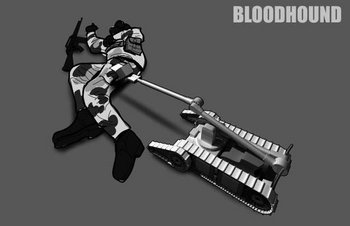
iRobot seems to be working on a semi-autonomous medicbot for the military, as evidenced by this paper from the 23rd Army Science Conference: “Bloodhound: A Semi-Autonomous Battlefield Medical Robot”. [via engadget, whose paid authors should perhaps worry more about correcting basic grammatical errors than posting 40 times a day.]
In the future, medical robots like Bloodhound (Figure 1) will save soldiers and medics from this lethal dilemma. The Personal Status Monitors (PSMs) and smart uniforms being developed by the Army will detect when a soldier is wounded and notify a medic of the soldier’s GPS location. If the soldier is under fire, the medic will deploy a Bloodhound to that location. This robot will navigate autonomously to the soldier, carrying payloads for diagnosis and treatment. While the robot navigates to the soldier, the medic will be free to treat other casualties or dispatch robots to other locations.
When Bloodhound arrives at the casualty, it will alert the medic, and the medic will be able to perform a detailed examination of the casualty through the robot’s sensors. These sensors will include video cameras, twoway audio, an electronic stethoscope, and other diagnostic devices. The robot’s manipulator arm will allow the medic to position the sensors to best examine the casualty. After determining the extent of the casualty’s injuries, the medic will be able to treat these injuries using onboard medical payloads. In addition to allowing remote medical care, Bloodhound will reduce the load that a medic needs to carry, one of the key goals of Objective Force Warrior.
[...]
Using these guidelines, the following payloads have been selected as candidates for implementation in Phase II:
- Hemostasis payloads (fibrin bandages, liquid fibrin sealants, inflatable bandages)
- Auto-injectors (for morphine, epinephrine, and nerve agent antidotes)
- Electronic stethoscopes and other diagnostic devices
- Biological and chemical weapon sensors
Exploring the Army Science Conference site made me think of “How We Lost the High-Tech War of 2007”, from The Weekly Standard:
Posted by jjwiseman at July 06, 2004 08:16 AMBecause the Americans believed their information technologies reduced the need for conventional combat forces, they disbanded such forces in favor of trendy “information” units. These were filled not with well-trained, physically fit combatants, but rather, as Szafranski put it, “mind-nimble (not necessarily literate), fingertip-quick youth” who tended to equate their success at video games with competency to engage in real war. Thank The One Above, the easy capture of a few of these self-styled “digital warriors” yielded a treasure trove of intelligence data.
We found we could contend with the light, supposedly high-tech combat units that completed most of America's remaining battle forces